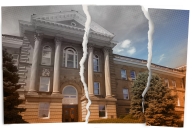You have /5 articles left.
Sign up for a free account or log in.
EASTON, PA. -- To paraphrase a quote from Mark Twain, as so many speakers here did this week, the demise of the residential liberal arts college may have been greatly exaggerated.
Few other sectors of higher education have seen the kind of doom-and-gloom rhetoric that liberal arts colleges have seen in recent years, with pundits frequently noting the outdated nature of the liberal arts model in a world that demands low-cost options, convenience and an education that prepares students for the working world.
But for the roughly 200 liberal arts college presidents and administrators who assembled here at Lafayette College this week for a conference entitled “The Future of the Liberal Arts College in America and Its Leadership Role in Education Around the World,” there’s a sense that the rhetoric might be a little overheated.
Despite significant looming challenges related to affordability, access, public skepticism about value, changing student demographics, and the influence of technology on students and education -- which all the attendees readily acknowledged -- most of the presidents of the liberal arts colleges here this week aren’t planning on substantively changing to how their institutions operate or their economic models.
While the institutions represented here did not think broad reforms were necessary, that mindset might not extend to all residential liberal arts colleges. Conference attendees hailed from institutions at the top of U.S. News and World Report's ranking of national liberal arts colleges, which tend to have larger endowments, continuing high demand from families willing to pay high sticker prices, and significant alumni support that can subsidize the education of all students. Many liberal arts colleges don't have those benefits and could see more financial and public pressure to dramatically change how they operate.
The institutions represented at the Lafayette conference will tinker around the edges, to be sure, and presenters rattled off a litany of programs they’ve implemented in recent years to address the looming challenges. But, judging by the conference discussion, the heart of their sector is going to remain intact.
In order to avoid significant change (or irrelevancy), however, conference attendees noted that they are going to have to do a better job cutting through the prevailing discussion surrounding higher education to explain what they do and why it is valuable to various constituents, including the parents they are asking to write large checks, policy makers who seek to cut support and increase regulation, and a public that is generally skeptical about these institutions’ value.
“We must continue to stay the course, not make concessions to a population that does not understand what we do, and make the case that what we do is valuable.”
--Daniel H. Weiss, Lafayette
“We need a narrative that provides a rationale to our many publics and guides our decision making and life together,” said Rebecca S. Chopp, president of Swarthmore College.
A common refrain from the conference was that it’s not the liberal arts colleges that are broken, but rather the conversation that they have been caught up in. In his keynote address Tuesday night, William G. Bowen, former president of Princeton University and the Andrew W. Mellon Foundation, extolled what he viewed as the many things liberal arts college do right, particularly how they educate students.
“The ability to function effectively in collaborative settings with all kinds of people, to identify a problem, parse it out, and make headway toward solving it, all in the company of others, are going to be crucial skills going forward,” he said.
The types of colleges represented tend to have a reputation for providing a good education, attracting bright students and producing successful alumni. But the presidents noted how the current rhetoric about higher education in many cases runs directly counter to what their institutions do. Politicians want more students to graduate from college, a lower cost per degree, a more convenient educational process, and better connection between what students learn in college and the working world.
But liberal arts colleges are reluctant to expand in size out of fear of diminishing the quality of their experience. Their small-class and residential-campus models are expensive to provide, as are the financial aid programs they deploy to ensure diverse student bodies. Administrators fear breaking down the four-year, full-time model, which they believe is crucial to developing well-rounded students. And the liberal arts curriculum isn’t necessarily tied to preparing students for a specific career, and certainly not a single job.
"We must continue to stay the course, not make concessions to a population that does not understand what we do, and make the case that what we do is valuable,” Daniel H. Weiss, Lafayette's president, said in his closing remarks for the conference.
In talks Wednesday, presidents highlighted what they believed to be two of the most distinctive aspects of their institutions: an educational model that they say prepares students for a working world in which they will hold a series of often unrelated jobs, and a residential model that could be used to teach students about engaging with individuals from diverse backgrounds, which administrators say will be pivotal to solving challenges the country faces. It is upon these two themes that they began to construct a new narrative they hope will respond to the criticism.
Cutting through the rhetoric is a taller order than it might seem. While liberal arts colleges are numerous, they only enroll about 5 percent of the total college-going population. By tradition they tend to be “walled gardens” -- a phrase that came up repeatedly over the course of the conference -- and reluctant to engage much with the outside world.
At one point, presidents noted that there’s not necessarily an association or single spokesperson that specifically represents the interests of the types of colleges assembled here, specifically residential liberal arts colleges. Groups such as the Annapolis Group represent only a narrow band of residential liberal arts colleges -- the elite ones -- and the Council of Independent Colleges represents a group so broad (roughly 600 mostly small, private colleges) that the concerns of one type of institution often don’t rise to the surface.
The presidents also noted the need to better document their learning outcomes, in both quantitative and qualitative terms, a task that has proved challenging for much of higher education.
While the prevailing sentiment was that rhetoric would be the key weapon in helping advance liberal arts colleges’ interests in the future, some presidents noted that shifting the conversation might not necessarily be enough. “It’s important, but it’s not sufficient,” said Brian Rosenberg, president of Macalester College, after the conference ended.
In his presentation Tuesday, Rosenberg said colleges probably have to do a better job of connecting what students are learning in the classroom to what’s going on in the world around them, to further the argument that liberal arts colleges provide a social good.
The changes to the educational and residential models that have been highlighted and proposed over the course of the conference, such as the use of technology to collaborative teach courses with other institutions, more internship and externship programs that get students out of the classroom and into the professional world, and rethinking the curriculum to teach more about the challenges and opportunities posed by technology, diversity, globalization, and sustainability, might seem relatively minor in comparison to other sectors that are making sweeping changes to how they operate, but such changes can be revolutionary for institutions that have operated under a relatively stable model for more than a century.
While the presidents here mostly believe that the education their colleges offer is better than what you’ll find at most other types of institutions, they noted room for improvement. And they acknowledged that liberal arts colleges, which bill themselves as being the best form of undergraduate education, should constantly be striving to be on the cutting edge of good instruction.
Several presidents talked about the need to infuse interdisciplinarity into the curriculum, as students are coming to expect. “Our institutions stand for a broader and deeper form of understanding,” said David Oxtoby, president of Pomona College. “It’s our job to ensure that our product lives up to that promise.”
Given the relatively small size of faculties at liberal arts colleges, and the collegial nature of the colleges, Oxtoby and others said that such environments should make for more collaboration -- but that that is not always the case.
Chopp talked about the need to make the residential experience more “intentional,” meaning colleges take bigger steps toward evoking an educational experience from what students do outside the classroom. Ronald A. Crutcher, president of Wheaton College, in Massachusetts, suggested that the residential experience should push students to engage in questions about diversity and globalization, two issues he saw as looming challenges for the country over the next century and two issues the residential model might be uniquely positioned to address.
The parting sentiment for the conference, which wrapped up Wednesday afternoon, was that presidents should both talk the talk, becoming increasingly engaged in discussions about higher education and the institutions' place in it, and walk the walk, enacting changes that continue to improve the quality of education and experience at their institutions to justify what they’re asking parents to pay. But one theme that strung the conference together, Chopp noted, was the call for collaboration over the next few years, whether it’s within an individual college or among different colleges.
After all, learning to tie disparate ideas together to solve a problem is frequently touted as one of the chief benefits of a liberal arts education.








